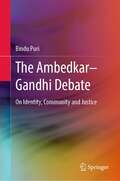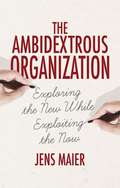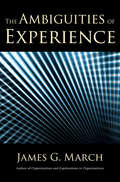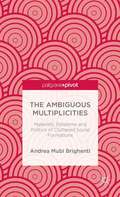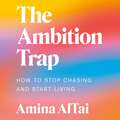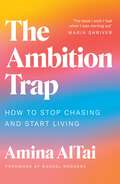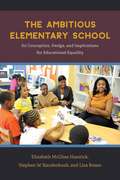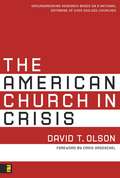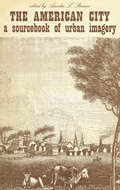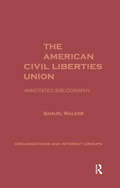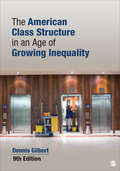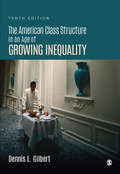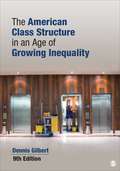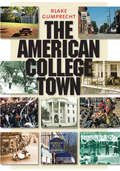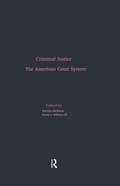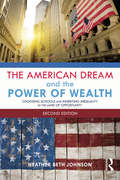- Table View
- List View
The Ambedkar–Gandhi Debate: On Identity, Community and Justice
by Bindu PuriThis book reconstructs the philosophical issues informing the debate between the makers of modern India: Ambedkar and Gandhi. At one level, this debate was about a set of different but interconnected issues: caste and social hierarchies, untouchability, Hinduism, conversion, temple entry, and political separatism. The introduction to this book provides a brief overview of the engagements and conflicts in Gandhi and Ambedkar's central arguments. However, at another level, this book argues that the debate can be philosophically re-interpreted as raising their differences on the following issues: The nature of the self,The relationship between the individual self and the community,The appropriate relationship between the constitutive encumbrances of the self and a conception of justice,The relationship between memory, tradition, and self-identity. Ambedkar and Gandhi’s contrary conceptions of the self, history,itihaas, community and justice unpack incommensurable world views. These can be properly articulated only as very different answers to questions about the relationship between the present and the past. This book raises these questions and also establishes the link between the Ambedkar--Gandhi debate in the early 20th century and its re-interpretation as it resonates in the imagination and writing of marginalized social groups in the present times.
The Ambidextrous Organization
by Jens MaierHow can businesses balance the different demands of both exploiting and exploring? Organizations and their leaders have to use both hands: on the one hand making next quarter's targets through existing business, whilst simultaneously exploring new opportunities. Mega-trends such as ageing populations, mobile technology and renewable energy are creating new opportunities for innovation that require links and convergences between industries, and leaders have to face the challenge of steering their organizations through this unchartered territory. Traditional management approaches will not work: both leaders and their organizations have to be geared towards ambidexterity. This is the first book to truly explain how to harness the power of this approachto encourage innovation. With examples from Nespresso, Daimler Benz, Zurich Financial, Intel, and industries such as packaging, pharmaceuticals, telecoms, this book identifies key challenges around: organizational perspectives; individual leaders; internal processes and culture at both the organizational and individual level. The second part provides solutions, including linking corporate and individual development; external scouting; purposeful convergence engineering; creating appropriate partnerships and approaches to managing risk.
The Ambiguities of Experience
by James G. March"The first component of intelligence involves effective adaptation to an environment. In order to adapt effectively, organizations require resources, capabilities at using them, knowledge about the worlds in which they exist, good fortune, and good decisions. They typically face competition for resources and uncertainties about the future. Many, but possibly not all, of the factors determining their fates are outside their control. Populations of organizations and individual organizations survive, in part, presumably because they possess adaptive intelligence; but survival is by no means assured. The second component of intelligence involves the elegance of interpretations of the experiences of life. Such interpretations encompass both theories of history and philosophies of meaning, but they go beyond such things to comprehend the grubby details of daily existence. Interpretations decorate human existence. They make a claim to significance that is independent of their contribution to effective action. Such intelligence glories in the contemplation, comprehension, and appreciation of life, not just the control of it."—from The Ambiguities of Experience In The Ambiguities of Experience, James G. March asks a deceptively simple question: What is, or should be, the role of experience in creating intelligence, particularly in organizations? Folk wisdom both trumpets the significance of experience and warns of its inadequacies. On one hand, experience is described as the best teacher. On the other hand, experience is described as the teacher of fools, of those unable or unwilling to learn from accumulated knowledge or the teaching of experts. The disagreement between those folk aphorisms reflects profound questions about the human pursuit of intelligence through learning from experience that have long confronted philosophers and social scientists. This book considers the unexpected problems organizations (and the individuals in them) face when they rely on experience to adapt, improve, and survive.While acknowledging the power of learning from experience and the extensive use of experience as a basis for adaptation and for constructing stories and models of history, this book examines the problems with such learning. March argues that although individuals and organizations are eager to derive intelligence from experience, the inferences stemming from that eagerness are often misguided. The problems lie partly in errors in how people think, but even more so in properties of experience that confound learning from it. "Experience," March concludes, "may possibly be the best teacher, but it is not a particularly good teacher."
The Ambiguous Multiplicities: Materials, Episteme and Politics of Cluttered Social Formations
by Andrea Mubi BrighentiThis book proposes a historical-conceptual journey into the cluttered social formations that have remained outside of mainstream sociology. In particular, it reviews urban crowds, mediated publics, global masses, population, the sovereign people and the multitude and addresses the question: 'What is the building block of the social?'.
The Ambition Trap: How to Stop Chasing and Start Living
by Amina AlTai"This is the book I wish I had when I was starting out and even when I was knee-deep thinking success was the be-all and end-all." MARIA SHRIVERThe anti-hustle guide to getting what you want - without burning outIf you ever feel like your ambition comes at the cost of feeling exhausted - that no matter how hard you work, or what you achieve, it's never quite enough - welcome to the ambition trap.Most of us think being ambitious means doing everything in our power to get ahead. But this approach doesn't work: it's bad for our health and makes it impossible to have the happiness and success we want.Drawing on her work with Fortune 500 leaders, Olympic gold medallists and start-up founders, leadership coach Amina AlTai guides you to achieve more of what really matters. In doing so, she shares a new way to break the cycle of overwork and create the greatest, most joy-filled work of your life.Her method is not about being complacent or giving up on your dreams. It's about anchoring your ambition to your purpose. She explains actionable strategies for aligning your work with your deepest 'why', setting a sustainable pace of growth, nourishing yourself in the long-term pursuit of your goals, and allowing contentment to lead the way.Follow Amina's advice and you'll live your life with greater meaning and fulfilment.
The Ambition Trap: How to Stop Chasing and Start Living
by Amina AlTai"This is the book I wish I had when I was starting out and even when I was knee-deep thinking success was the be-all and end-all." MARIA SHRIVERThe anti-hustle guide to getting what you want - without burning outIf you ever feel like your ambition comes at the cost of feeling exhausted - that no matter how hard you work, or what you achieve, it's never quite enough - welcome to the ambition trap.Most of us think being ambitious means doing everything in our power to get ahead. But this approach doesn't work: it's bad for our health and makes it impossible to have the happiness and success we want.Drawing on her work with Fortune 500 leaders, Olympic gold medallists and start-up founders, leadership coach Amina AlTai guides you to achieve more of what really matters. In doing so, she shares a new way to break the cycle of overwork and create the greatest, most joy-filled work of your life.Her method is not about being complacent or giving up on your dreams. It's about anchoring your ambition to your purpose. She explains actionable strategies for aligning your work with your deepest 'why', setting a sustainable pace of growth, nourishing yourself in the long-term pursuit of your goals, and allowing contentment to lead the way.Follow Amina's advice and you'll live your life with greater meaning and fulfilment.
The Ambitious Elementary School: Its Conception, Design, and Implications for Educational Equality
by Lisa Rosen Stephen W. Raudenbush Elizabeth McGhee HassrickThe challenge of overcoming educational inequality in the United States can sometimes appear overwhelming, and great controversy exists as to whether or not elementary schools are up to the task, whether they can ameliorate existing social inequalities and initiate opportunities for economic and civic flourishing for all children. This book shows what can happen when you rethink schools from the ground up with precisely these goals in mind, approaching educational inequality and its entrenched causes head on, student by student. Drawing on an in-depth study of real schools on the South Side of Chicago, Elizabeth McGhee Hassrick, Stephen W. Raudenbush, and Lisa Rosen argue that effectively meeting the challenge of educational inequality requires a complete reorganization of institutional structures as well as wholly new norms, values, and practices that are animated by a relentless commitment to student learning. They examine a model that pulls teachers out of their isolated classrooms and places them into collaborative environments where they can share their curricula, teaching methods, and assessments of student progress with a school-based network of peers, parents, and other professionals. Within this structure, teachers, school leaders, social workers, and parents collaborate to ensure that every child receives instruction tailored to his or her developing skills. Cooperating schools share new tools for assessment and instruction and become sites for the training of new teachers. Parents become respected partners, and expert practitioners work with researchers to evaluate their work and refine their models for educational organization and practice. The authors show not only what such a model looks like but the dramatic results it produces for student learning and achievement. The result is a fresh, deeply informed, and remarkably clear portrait of school reform that directly addresses the real problems of educational inequality.
The American Academic Profession: Transformation in Contemporary Higher Education
by Joseph C. HermanowiczThe academic profession, like many others, is rapidly being transformed. This book explores the current challenges to the profession and their broad implications for American higher education.Examining what professors do and how academia is changing, contributors to this volume assess current and potential threats to the profession. Leading scholars in sociology and higher education explore such topics as structural and cognitive change, socialization and deviance, career development, and professional autonomy and regulation. A comprehensive analysis of the significant questions facing this crucial profession, The American Academic Profession will be welcomed by students and scholars as well as by administrators and policy makers concerned with the future of the academy.
The American Bourgeoisie: Distinction and Identity in the Nineteenth Century
by Sven Beckert Julia B. RosenbaumThis volume engages a fundamental disciplinary question about this period in American history: how did the bourgeoisie consolidate their power and fashion themselves not simply as economic leaders but as cultural innovators and arbiters? It also explains how culture helped Americans form both a sense of shared identity and a sense of difference.
The American Census
by Margo AndersonThis book, published on the eve of the bicentennial of the American census, is the first social history of this remarkably important institution, from its origins in 1790 to the present. Margo Anderson argues that the census has always been an influential policymaking tool, used not only to determine the number of representatives apportioned to each state but also to allocate tax dollars to states, and, in the past, to define groups-such as slaves and immigrants-who were to be excluded from the American polity.
The American Century: Varieties of Culture In Modern Times
by Norman Cantor Mindy CantorAnalysis of the strengths of the twentieth-century in the United States
The American Church in Crisis
by David T. OlsonDirector of church planting for the Evangelical Covenant Church, Minnesota-based Olson cites data reported by over 200,000 orthodox Christian churches to raise an alarm, though not in an alarmist manner, he says. On any given Sunday, he says, the vast majority of Americans are absent from church, and church attendance is not keeping up with the country's population growth. Chapter-end questions for reflection and discussion are included, but no index. Annotation ©2008 Book News, Inc. , Portland, OR (booknews. com)
The American City in Crime Films: Criminology and the Cinematic City (Routledge Studies in Crime, Culture and Media)
by Andrew J. BaranauskasAnalyzing crime movies set in Detroit, Miami, Boston, Las Vegas, and the fictional Gotham City, this book examines the role that American cities play as characters in crime films. Furthering our awareness of how popular media shapes public understanding of crime and justice in American cities, this book contributes to scholarship in popular criminology by providing insight into the development of criminological theory in cinematic representations of crime and urban space. Each chapter focuses on a different city, starting with an overview of the social, economic, and political history of the city and proceeding to discuss the cinematic depiction of crime and justice in the city. At the heart of each chapter is a discussion of themes that are common across films set in each city. For each theme, the book makes connections to the criminological theory discussed in that chapter and concludes by focusing on real-world implications that stem from the social construction of urban crime in crime films.Bridging the gap between criminology and media studies, The American City in Crime Films will appeal to students of criminology and media studies, and urban sociology/criminology.
The American City: A Sourcebook of Urban Imagery
by David RiesmanThis set of readings presents useful insights into urbanization and provides a fresh perspective on American cities and their inhabitants. Advancing the premise that it is not possible to understand how people live in cities without understanding how they think of them, the editor presents historical and contemporary materials that illustrate vividly the variety of ways in which Americans have viewed their cities, and urbanization in general.This book sheds light on what the city is and does by analyzing what its citizens think it should be and do. Its lively, readable selections include contributions from businessmen, ministers, journalists, reporters, city planners, and reformers, as well as sociologists. Strauss shows that Americans' views of cities have been profoundly influenced by their history of continental expansion, successive waves of immigration, massive industrialization and similar objective developments. He points out that certain perspectives or themes relations of social classes within the city, of country to city, of small city to big city, of city to region, etc.persist regardless of the social or historical perspective of the writer.The author's comprehensive introduction and his introductions to each section of the book delineate the thematic structure of the readings and guide the reader toward the insights and principles illuminated in the different sections. A fruitful contribution to courses in urban sociology, the book is a useful addition to the libraries of sociologists, political scientists, planners, and city officials who wish to understand more fully the contemporary urban milieu.
The American Civil Liberties Union: An Annotated Bibliography (Organizations and Interest Groups)
by Samuel WalkerSince its founding after World War I, the American Civil Liberties Union has become an integral part of American society. The history of the ACLU parallels the extension of civil rights and liberties in the United States. With a total of 1454 entries spanning almost three quarters of a century, this annotated bibliography provides an important research tool for scholars, attorneys, and policy analysts. The author has organized the work into six chapters: general works concerning the ACLU, the history of the organization, contemporary and related civil liberties issues, ACLU leaders, and resources to guide scholars.
The American Class Structure (6th edition)
by Dennis GilbertHistory of class development in the United States
The American Class Structure in an Age of Growing Inequality
by Dennis L. GilbertLike its predecessors, the Ninth Edition of Dennis Gilbert’s The American Class Structure in an Age of Growing Inequality, focuses on the socioeconomic core of the American class system. Drawing on classic and contemporary studies, Gilbert describes our class structure and shows how class affects our everyday lives, from the way we raise our children to the way we vote. The major theme running through the book is the increasing inequality in American society. Gilbert describes the shift in the mid-1970s from an “Age of Shared Prosperity” to an “Age of Growing Inequality.” Using the most recent wage, income, and wealth statistics, and accounts of the shifting balance of class power in national politics, the author traces the widening disparities between the privileged classes and average Americans. He repeatedly returns to the question, “Why is this happening?” A variety of economic, political, and social factors are examined, and the competing explanations of influential writers are critically assessed, concluding with the author’s synthesis of the book’s lessons about the power of class and the forces behind growing inequality.
The American Class Structure in an Age of Growing Inequality
by Dennis L. GilbertWith the latest data on income, wealth, earnings, and residential segregation by income, The American Class Structure in an Age of Growing Inequality, Tenth Edition describes a consistent pattern of growing inequality in the United States since the early 1970s. Focusing on the socioeconomic core of the American class system, author Dennis L. Gilbert examines how changes in the economy, family life, globalization, and politics are contributing to increasing class inequality. New to this Edition “The Class Basis of Trump's Victory” looks at why for the first time since before the 1932 election, the Republican presidential candidate won a greater proportion of the working class vote than the Democratic opponent. Addresses the role of technology and other factors in the decline of manufacturing employment and how the trend is crucial for understanding growing inequality and changes in working class family life. Offers international comparisons to show how the U.S. compares with other wealthy nations on social mobility and poverty, and questions our conception of the U.S. as a uniquely open society.
The American Class Structure in an Age of Growing Inequality
by Dennis L. GilbertWith the latest data on income, wealth, earnings, and residential segregation by income, The American Class Structure in an Age of Growing Inequality, Tenth Edition describes a consistent pattern of growing inequality in the United States since the early 1970s. Focusing on the socioeconomic core of the American class system, author Dennis L. Gilbert examines how changes in the economy, family life, globalization, and politics are contributing to increasing class inequality. New to this Edition “The Class Basis of Trump's Victory” looks at why for the first time since before the 1932 election, the Republican presidential candidate won a greater proportion of the working class vote than the Democratic opponent. Addresses the role of technology and other factors in the decline of manufacturing employment and how the trend is crucial for understanding growing inequality and changes in working class family life. Offers international comparisons to show how the U.S. compares with other wealthy nations on social mobility and poverty, and questions our conception of the U.S. as a uniquely open society.
The American Class Structure in an Age of Growing Inequality (Ninth Edition)
by Dennis L. GilbertLike its predecessors, the Ninth Edition of Dennis Gilbert's The American Class Structure in an Age of Growing Inequality, focuses on the socioeconomic core of the American class system. Drawing on classic and contemporary studies, Gilbert describes our class structure and shows how class affects our everyday lives, from the way we raise our children to the way we vote. The major theme running through the book is the increasing inequality in American society. Gilbert describes the shift in the mid-1970s from an "Age of Shared Prosperity" to an "Age of Growing Inequality. " Using the most recent wage, income, and wealth statistics, and accounts of the shifting balance of class power in national politics, the author traces the widening disparities between the privileged classes and average Americans. He repeatedly returns to the question, "Why is this happening?" A variety of economic, political, and social factors are examined, and the competing explanations of influential writers are critically assessed, concluding with the author's synthesis of the book's lessons about the power of class and the forces behind growing inequality.
The American College Town
by Blake GumprechtThe college town is a unique type of urban place, shaped by the sometimes conflicting forces of youth, intellect, and idealism. The hundreds of college towns in the United States are, in essence, an academic archipelago. Similar to one another, they differ in fundamental ways from other cities and the regions in which they are located. In this highly readable book--the first work published on the subject--Blake Gumprecht identifies the distinguishing features of college towns, explains why they have developed as they have in the United States, and examines in depth various characteristics that make them unusual. In eight thematic chapters, he explores some of the most interesting aspects of college towns--their distinctive residential and commercial districts, their unconventional political cultures, their status as bohemian islands, their emergence as high-tech centers, and more. Each of these chapters focuses on a single college town as an example, while providing additional evidence from other towns. Lively, richly detailed, and profusely illustrated with original maps and photographs, as well as historical images, this is an important book that firmly establishes the college town as an integral component of the American experience.
The American Congress Reader
by Steven S. Smith Ryan J. Vander Wielen Jason M. Roberts Steven S. Smith Jason M. RobertsThe American Congress Reader provides a supplement to the popular and newly updated American Congress undergraduate textbook. By the same authors who drew upon Capitol Hill experience and nationally recognized scholarship to present a crisp introduction and analysis of Congress's inner mechanics, the Reader compiles the best relevant scholarship on party and committee systems, leadership, voting, and floor activity to broaden and illuminate the key features of the text.
The American Court System (Criminal Justice: Contemporary Literature in Theory and Practice #5)
by Marilyn McShaneDepending on whom one talks to, today's criminal courts are either the savior or the demon of our social order. While everyone seems to have an answer about what needs to be done, the solutions are neither simple, nor within our current allocation of resources. Media hype and political posturing emotionally dilute the reality of what motivates crime and what constitutes effective punishment. The essays and research in this anthology give the reader a realistic view of complex problems affecting our juvenile and adult courts and, consequently, the rest of the criminal justice system. Topics include sentencing disparity, sentencing reform, and wrongful convictions. Some traditionally controversial issues are covered, such as the insanity defense and the death penalty as well as the more recent "three-strikes-and-you're-out" movement and mandatory minimums. This series will be of great utility to students, scholars, and others with interests in the literature of criminal justice and criminology.
The American Dream and the Power of Wealth: Choosing Schools and Inheriting Inequality in the Land of Opportunity
by Heather Beth JohnsonDespite the overwhelming evidence against them, many people still believe they can overcome the economic and racial constraints placed upon them at birth. In the first edition, Heather Beth Johnson explored this belief in the American Dream with over 200 in-depth interviews with black and white families, highlighting the ever-increasing racial wealth gap and the actual inequality in opportunities. This second edition has been updated to make it fully relevant to today’s reader, with new data and illustrative examples, including twenty new interviews. Johnson asks not just what parents are thinking about inequality and the American Dream, but to what extent children believe in the American Dream and how they explain, justify, and understand the stratification of American society. This book is an ideal addition to courses on race and inequality.
The American Drug Culture
by Thomas S. Weinberg Professor Gerhard J. falk Dr Ursula Adler FalkThe American Drug Culture uses sociological and other perspectives to examine drug and alcohol use in U.S. society. The text is arranged topically, rather than by categories of drugs, and explores diverse contexts of drug use including popular culture; sexuality; the legal and criminal justice systems; other social institutions; and mental and physical health. It features more coverage of alcohol, the most widely-used drug in the U.S., than other texts for this course. Authors Thomas S. Weinberg, Gerhard Falk, and Ursula Falk include case studies from their field research to give you empathetic insights into the situation of those with substance and alcohol use disorders.
